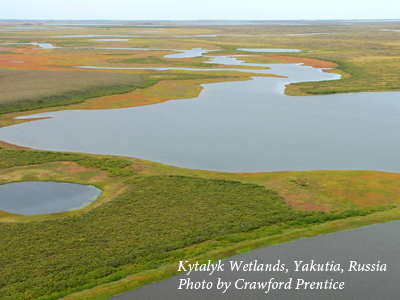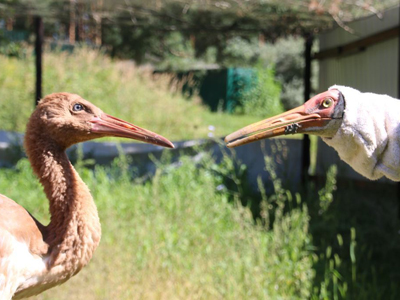 This August, International Crane Foundation volunteer Jamie Gamble and I visited Russia for eight days on a mission to help the Critically Endangered Siberian Crane. Jamie is a pilot who has volunteered his time and aircraft through a private organization, Lighthawk, to survey reintroduced Whooping Cranes on their breeding grounds in Wisconsin.
This August, International Crane Foundation volunteer Jamie Gamble and I visited Russia for eight days on a mission to help the Critically Endangered Siberian Crane. Jamie is a pilot who has volunteered his time and aircraft through a private organization, Lighthawk, to survey reintroduced Whooping Cranes on their breeding grounds in Wisconsin.
Our voyage took us on a 7 hour flight from Moscow to the far-eastern Russian city, Yakutsk, the capital of Yakutia – a republic of Russia four times larger than Texas. Approximately 4,000 Siberian Cranes breed in the arctic regions of northern Yakutia and migrate across a continent to winter over 3,200 miles south at Poyang Lake in China.
Our goal was to collaborate with our colleagues to plan a series of comprehensive aerial surveys to be done in June 2016 to locate Siberian Cranes suspected to be nesting in three vast wetlands complexes within the forests of eastern Russia. With the possibility that such wetlands are perched atop deposits of valuable minerals and petroleum, research on the distribution of breeding cranes is imperative if habitat conservation is to precede potential industry.
Our proposal was enthusiastically endorsed. We hope to return next year to join Russian colleagues in these surveys and to celebrate 20 years of collaboration between the International Crane Foundation and Yakutians in the conservation of Siberian Cranes. Our sincere thanks are extended to our colleagues at the Yakutsk Institute of the Biological Problems of the Permafrost Zone, Dr. Nickolai Germogenov, and Dr. Inga Bysykatova.
Until recent decades, there were two additional populations of Siberian Cranes. They nested in north-central areas of Russia and wintered in India and Iran. Hunting along the migration route of the western flocks likely spelled their demise. The last bird was seen in India in 2003, and only a lone crane continues to come to Iran.
 With the hope of reestablishing Siberian Cranes in central Asia using techniques developed for reintroduction programs for Whooping Cranes in eastern North America, a flourishing captive population has been established at the Oka Biosphere Nature Reserve (OBNR), about 200 miles south of Moscow.
With the hope of reestablishing Siberian Cranes in central Asia using techniques developed for reintroduction programs for Whooping Cranes in eastern North America, a flourishing captive population has been established at the Oka Biosphere Nature Reserve (OBNR), about 200 miles south of Moscow.
My first visit to OBNR was in 1978, when the first Siberian Crane chick was hatched and reared from an egg taken from the nest of a pair of cranes in Yakutia. Over the past 37 years, 203 Siberian Cranes have been raised at OBNR from eggs produced by their captive pairs. Many of these cranes have been used in experiments to develop techniques for returning Sibes to the wild in central Asia.
Jamie and I shared three heart-warming days with colleagues and captive cranes at OBNR. It was of great personal reward to be hosted by the director of the Crane Breeding Center, Dr. Tatiana Kashentseva and her sons, Arkadiy and Kirill, who were born not long after that first crane hatched at OBNR. Kirill is now his mother’s deputy in crane research and management, and Arkadiy and his father, Alexiy, are wardens. I have treasured the remarkable hospitality and warmth of this family for almost four decades.
Although many hurdles have been scaled, reestablishing a self-sustaining population of Whooping Cranes in North America, or of Siberian Cranes in central Asia, has yet to be achieved. We continue to learn from one another in the science and art of captive breeding and reintroduction. Concurrently, many kindred spirits on both continents continue efforts to sustain the remnant and self-sustaining flocks of wild Whooping and Siberian Cranes.
 Story submitted by Dr. George Archibald, International Crane Foundation Co-founder and Senior Conservationist. Click here to learn more about our work in East Asia.
Story submitted by Dr. George Archibald, International Crane Foundation Co-founder and Senior Conservationist. Click here to learn more about our work in East Asia.
